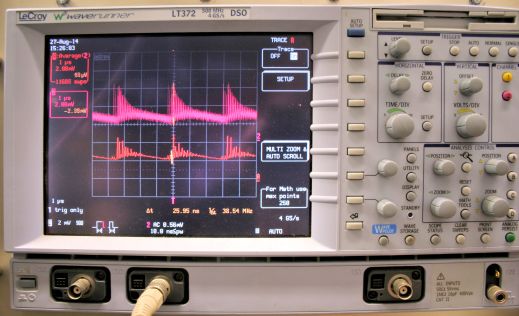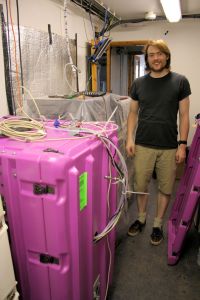Last day!
Today is my last day at the site, and I’m heading home tomorrow. The formaldehyde instrument is still running – Trev and Danny will pack that away on Monday. I’ve packed everything apart from the bare bones of the glyoxal instrument, which we have yet to move out of the lab (a very tight fit through the doors) and into the flight case ready to be shipped back to the UK.
The fieldwork has been a real success, with near-continuous measurements of glyoxal for both 4-week campaigns, and some promising measurements of formaldehyde during the second campaign. I’m pleased it’s gone so well, and I’m looking forward to getting back. We’re very grateful for the huge amount of help we’ve received from our colleagues in York and here in Cape Verde.
I think that’s all for now though I will try to post updates about the data analysis as we go along – thanks for reading!
Tidying up
Blazing sunshine, 27 degrees, and 92 % humidity…. what a day to start packing up!
We’re slowly winding down towards the end of the campaign now, so the task of packing the flight cases with equipment and stacking them in the shipping container has begun. It’s pretty sticky work!
The instruments will keep running until the last minute, and will be the last items to get packed away.
Island exploring
We woke up this morning to a hot and sunny Mindelo – no sign of yesterday’s rain. We popped to the site to check everything was still working (it was) and then set off on a bit of adventuring. Our plan was to see if we could get up to the volcano crater beyond Calhau. We have a map of Sao Vicente but it’s somewhat vague, so we ended up on a grand tour of the south east corner of the island, looking for the right track to get us close to the crater.
The first track we chose took past the volcano but the route up that side didn’t look very inviting (long, steep and rubbly), so we kept going to see where the track went. It took us into what felt like desert, where we got great views of some mountains (Pico do Vento and Topona), and spotted two osprey. The track ended right at the coast, at a place called Praia de Palma Carga where there’s a sandy beach, some rocky coastline, and more views of the mountains.
We had a look at the map and spotted a track that should lead us round the other side of the volcano, so we drove back the way we had come and kept an eye out for it. By the time we had nearly reached the main road we concluded that the track is either very well hidden or it doesn’t exist.
We had one more track to try, which took us past some farms and small buildings. It was both rougher and sandier than the track to Praia de Palma Carga, but I was reasonably confident the Jimny could handle it so we pressed on. The area near the road started to become familiar, and I realised I had walked up towards this track from Calhau during the last campaign. I had been aiming for the volcano crater but the heat and the rocky, sandy terrain got the better of me. Not so this time! We parked up and had a short but very hot walk up a path up the side of the volcano.
I wasn’t expecting the crater to be so big! A loose path took us down over the edge into the crater, where numerous people have gone to some effort to arrange boulders to spell out their initials and the date they visited. There is more vegetation inside the crater than outside, and goats clearly graze there from time to time.
Since we were feeling adventurous, we climbed out of the other side, and headed back round the rocky edge of the crater to the path we had taken up the side. From there it was an easy walk back to the car, and we were back in Mindelo in time for lunch.
Rain on the horizon?

It’s been a cloudy, gloomy, blustery day, with a big swell on the sea, drizzle this morning, and a slightly heavier shower this evening. Perhaps the annual rain will arrive this weekend!
Half time
We’re half-way through the campaign now. So far it’s not been as smooth as the previous campaign, but we’re hoping for a better second half! We will try (yet again) to calibrate the formaldehyde instrument this afternoon, and hopefully I’ll have some more interesting posts to add in the near future.
I haven’t got any science-y photos today, but I do have some of the cheeky visitors we get occasionally at the site, and each morning at the apartment.
Problem solving

New instruments (like our formaldehyde instrument) often only reveal their true colours when you get them in the field, creating problems which laboratory conditions don’t cause. Our aim is to fix what we can while we’re here, work out what we need to do back in the lab, and learn how to improve the instrument.
We’ve been looking at various signals (such as the frequency and stability of the laser pulse) on the oscilloscope (pictured above), which is a very handy way of visualising what’s going on in terms of signal processing inside the instrument.
One of the problems with the formaldehyde instrument – a poor connection between the laser and the timing control system – was difficult to diagnose but easy to fix, and measurements are underway once again.
One week in
We spent an hour or so today sorting out the detector pressure for the glyoxal instrument. It was previously controlled with a fiddly valve which needed adjusting now and then, requiring some crawling around under the instrument. It has now been replaced with a very short section of thin tubing, cut to exactly the right length to give the required pressure in the cell – about 90 Torr (about 0.1 bar).
After a lot of work Steve is now happy with his GC measurements of terpenes and halocarbons, and is going to run his first ambient sample this evening.
We’re having some trouble with the software for the formaldehyde instrument, so we had to abandon the calibration for the time being, and we’ve decided to stop the measurements for a short while. We hope to be able to fix it quickly, but these sort of problems are usually best solved after a bit of a break so we’re going to leave it switched off overnight.
Water, water, everywhere…
Well, not quite everywhere, but in a few places we don’t want it.
The relative humidity here is about 90 % and the outside temperature is 26 °C. It should have come as no surprise that when we drew warm, humid air from outside through a tube that runs a considerable distance through the cool, air-conditioned laboratory, some of the water vapour condensed on the inside of the tube. During the previous campaign both the relative humidity and temperature were lower, so we didn’t have so much of a problem.
Having discovered quite a lot of water in various places it shouldn’t have been yesterday afternoon (sample lines, pump exhaust lines, and possibly pumps) we spent the rest of the day and some of the evening fixing the problem. Thanks to Steve’s ingenuity and provision of some heating tape, Danny’s plug-wiring skills, and my handiness with cable ties, tape, pipe lagging, and foil bubble wrap, I think we’ve got it sorted.
The lab now looks a bit like the set of a budget sci-fi space travel film, with black and silvery tubes dangling around, but it should keep liquid water away from our instruments.
On the plus side, I did a successful calibration of the glyoxal instrument yesterday, and we should get the formaldehyde instrument calibrated today.
We’re still hoping for some proper rain!
Quick update
Just a quick update for now: The formaldehyde and glyoxal instruments are running, and Steve is hard at work with the GC-MS (gas chromatography – mass spectroscopy) instrument. At the moment the hinges on the main door to the container are being replaced, so we’re stuck in the lab for the time being while the welding is finished. That’s no bad thing – it’s a nice temperature in here, and we’re happily watching the signal from our instruments, looking for any sign of increased formaldehyde from the work going on outside.
We’ll post some details about the formaldehyde instrument at a later date.
A tricky start
We arrived in Cape Verde for the second measurement campaign on Saturday, and we’ve been very busy at the site since then.
Getting the formaldehyde instrument from the ‘storage’ container, across the site, and into the lab, was quite a challenge (somehow the wheels for the instrument got left in Leeds) and I’m glad there were three of us to do it, though I think Danny and Steve did most of the muscle work in the end. It’s safely in place now and has been measuring quite happily for a couple of days. The glyoxal instrument required a lot less effort this time as it was left in place at the end of the last campaign, and it’s currently up and running. The laboratory is now packed with instruments, and we have to be careful when moving around the lab so that we don’t bump into something or someone.
We had a bit of excitement yesterday when we detected a lot of formaldehyde. Sadly, for us, it turned out to be a problem with the vacuum pump which pulls ambient air through the glass tube from which we sample. Thanks to Steve’s mechanical know-how, and a really long day at the site, the pump is now fixed!
We had a bit of rain on the day we arrived. Well, I would count it as rain, but it didn’t really count according to the locals, some of whom say that they don’t think the ‘real’ rain will come at all this year. We’ll wait and see.
I’ve not been able to upload any photos to the blog yet but I should be able to get that sorted soon, so do keep an eye out for some shots of the lab and beyond.



















